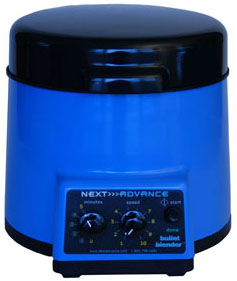Ideal for Tissue Dissociation
|
||
Save Time, Effort and Get Superior Results with |
||
 |
|
|
 |
| Do you spend lots of time and effort homogenizing tissue samples? The Bullet Blender® is a multi-sample homogenizer that delivers superior results. No other homogenizer comes close to delivering the Bullet Blender’s winning combination of top-quality performance and budget-friendly affordability. | |
|
|
Bullet Blender settings for Tissue Dissociation
Sample size |
See the Protocol |
| microcentrifuge tube model (up to 300 mg) | Small spleen samples for generation of splenocytes |
Selected publications for Tissue Dissociation
See all of our Bullet Blender publications!
2474232
cell suspension
1
apa
50
date
desc
3283
https://www.nextadvance.com/wp-content/plugins/zotpress/
%7B%22status%22%3A%22success%22%2C%22updateneeded%22%3Afalse%2C%22instance%22%3Afalse%2C%22meta%22%3A%7B%22request_last%22%3A0%2C%22request_next%22%3A0%2C%22used_cache%22%3Atrue%7D%2C%22data%22%3A%5B%7B%22key%22%3A%223UNSVA46%22%2C%22library%22%3A%7B%22id%22%3A2474232%7D%2C%22meta%22%3A%7B%22creatorSummary%22%3A%22Booth%20et%20al.%22%2C%22parsedDate%22%3A%222015-09-17%22%2C%22numChildren%22%3A0%7D%2C%22bib%22%3A%22%26lt%3Bdiv%20class%3D%26quot%3Bcsl-bib-body%26quot%3B%20style%3D%26quot%3Bline-height%3A%202%3B%20padding-left%3A%201em%3B%20text-indent%3A-1em%3B%26quot%3B%26gt%3B%5Cn%20%20%26lt%3Bdiv%20class%3D%26quot%3Bcsl-entry%26quot%3B%26gt%3BBooth%2C%20J.%20S.%2C%20Salerno-Goncalves%2C%20R.%2C%20Blanchard%2C%20T.%20G.%2C%20Patil%2C%20S.%20A.%2C%20Kader%2C%20H.%20A.%2C%20Safta%2C%20A.%20M.%2C%20Morningstar%2C%20L.%20M.%2C%20Czinn%2C%20S.%20J.%2C%20Greenwald%2C%20B.%20D.%2C%20%26amp%3B%20Sztein%2C%20M.%20B.%20%282015%29.%20Mucosal-Associated%20Invariant%20T%20Cells%20in%20the%20Human%20Gastric%20Mucosa%20and%20Blood%3A%20Role%20in%20Helicobacter%20pylori%20Infection.%20%26lt%3Bi%26gt%3BFrontiers%20in%20Immunology%26lt%3B%5C%2Fi%26gt%3B%2C%20%26lt%3Bi%26gt%3B6%26lt%3B%5C%2Fi%26gt%3B.%20%26lt%3Ba%20class%3D%26%23039%3Bzp-DOIURL%26%23039%3B%20href%3D%26%23039%3Bhttps%3A%5C%2F%5C%2Fdoi.org%5C%2F10.3389%5C%2Ffimmu.2015.00466%26%23039%3B%26gt%3Bhttps%3A%5C%2F%5C%2Fdoi.org%5C%2F10.3389%5C%2Ffimmu.2015.00466%26lt%3B%5C%2Fa%26gt%3B%26lt%3B%5C%2Fdiv%26gt%3B%5Cn%26lt%3B%5C%2Fdiv%26gt%3B%22%2C%22data%22%3A%7B%22itemType%22%3A%22journalArticle%22%2C%22title%22%3A%22Mucosal-Associated%20Invariant%20T%20Cells%20in%20the%20Human%20Gastric%20Mucosa%20and%20Blood%3A%20Role%20in%20Helicobacter%20pylori%20Infection%22%2C%22creators%22%3A%5B%7B%22creatorType%22%3A%22author%22%2C%22firstName%22%3A%22Jayaum%20S.%22%2C%22lastName%22%3A%22Booth%22%7D%2C%7B%22creatorType%22%3A%22author%22%2C%22firstName%22%3A%22Rosangela%22%2C%22lastName%22%3A%22Salerno-Goncalves%22%7D%2C%7B%22creatorType%22%3A%22author%22%2C%22firstName%22%3A%22Thomas%20G.%22%2C%22lastName%22%3A%22Blanchard%22%7D%2C%7B%22creatorType%22%3A%22author%22%2C%22firstName%22%3A%22Seema%20A.%22%2C%22lastName%22%3A%22Patil%22%7D%2C%7B%22creatorType%22%3A%22author%22%2C%22firstName%22%3A%22Howard%20A.%22%2C%22lastName%22%3A%22Kader%22%7D%2C%7B%22creatorType%22%3A%22author%22%2C%22firstName%22%3A%22Anca%20M.%22%2C%22lastName%22%3A%22Safta%22%7D%2C%7B%22creatorType%22%3A%22author%22%2C%22firstName%22%3A%22Lindsay%20M.%22%2C%22lastName%22%3A%22Morningstar%22%7D%2C%7B%22creatorType%22%3A%22author%22%2C%22firstName%22%3A%22Steven%20J.%22%2C%22lastName%22%3A%22Czinn%22%7D%2C%7B%22creatorType%22%3A%22author%22%2C%22firstName%22%3A%22Bruce%20D.%22%2C%22lastName%22%3A%22Greenwald%22%7D%2C%7B%22creatorType%22%3A%22author%22%2C%22firstName%22%3A%22Marcelo%20B.%22%2C%22lastName%22%3A%22Sztein%22%7D%5D%2C%22abstractNote%22%3A%22%22%2C%22date%22%3A%222015-09-17%22%2C%22language%22%3A%22%22%2C%22DOI%22%3A%2210.3389%5C%2Ffimmu.2015.00466%22%2C%22ISSN%22%3A%221664-3224%22%2C%22url%22%3A%22http%3A%5C%2F%5C%2Fjournal.frontiersin.org%5C%2FArticle%5C%2F10.3389%5C%2Ffimmu.2015.00466%5C%2Fabstract%22%2C%22collections%22%3A%5B%22M2MNG549%22%5D%2C%22dateModified%22%3A%222015-12-30T17%3A13%3A28Z%22%7D%7D%2C%7B%22key%22%3A%22ISI7UVH4%22%2C%22library%22%3A%7B%22id%22%3A2474232%7D%2C%22meta%22%3A%7B%22creatorSummary%22%3A%22Booth%20et%20al.%22%2C%22parsedDate%22%3A%222014-06-19%22%2C%22numChildren%22%3A0%7D%2C%22bib%22%3A%22%26lt%3Bdiv%20class%3D%26quot%3Bcsl-bib-body%26quot%3B%20style%3D%26quot%3Bline-height%3A%202%3B%20padding-left%3A%201em%3B%20text-indent%3A-1em%3B%26quot%3B%26gt%3B%5Cn%20%20%26lt%3Bdiv%20class%3D%26quot%3Bcsl-entry%26quot%3B%26gt%3BBooth%2C%20J.%20S.%2C%20Toapanta%2C%20F.%20R.%2C%20Salerno-Goncalves%2C%20R.%2C%20Patil%2C%20S.%2C%20Kader%2C%20H.%20A.%2C%20Safta%2C%20A.%20M.%2C%20Czinn%2C%20S.%20J.%2C%20Greenwald%2C%20B.%20D.%2C%20%26amp%3B%20Sztein%2C%20M.%20B.%20%282014%29.%20Characterization%20and%20Functional%20Properties%20of%20Gastric%20Tissue-Resident%20Memory%20T%20Cells%20from%20Children%2C%20Adults%2C%20and%20the%20Elderly.%20%26lt%3Bi%26gt%3BFrontiers%20in%20Immunology%26lt%3B%5C%2Fi%26gt%3B%2C%20%26lt%3Bi%26gt%3B5%26lt%3B%5C%2Fi%26gt%3B.%20%26lt%3Ba%20class%3D%26%23039%3Bzp-DOIURL%26%23039%3B%20href%3D%26%23039%3Bhttps%3A%5C%2F%5C%2Fdoi.org%5C%2F10.3389%5C%2Ffimmu.2014.00294%26%23039%3B%26gt%3Bhttps%3A%5C%2F%5C%2Fdoi.org%5C%2F10.3389%5C%2Ffimmu.2014.00294%26lt%3B%5C%2Fa%26gt%3B%26lt%3B%5C%2Fdiv%26gt%3B%5Cn%26lt%3B%5C%2Fdiv%26gt%3B%22%2C%22data%22%3A%7B%22itemType%22%3A%22journalArticle%22%2C%22title%22%3A%22Characterization%20and%20Functional%20Properties%20of%20Gastric%20Tissue-Resident%20Memory%20T%20Cells%20from%20Children%2C%20Adults%2C%20and%20the%20Elderly%22%2C%22creators%22%3A%5B%7B%22creatorType%22%3A%22author%22%2C%22firstName%22%3A%22Jayaum%20S.%22%2C%22lastName%22%3A%22Booth%22%7D%2C%7B%22creatorType%22%3A%22author%22%2C%22firstName%22%3A%22Franklin%20R.%22%2C%22lastName%22%3A%22Toapanta%22%7D%2C%7B%22creatorType%22%3A%22author%22%2C%22firstName%22%3A%22Rosangela%22%2C%22lastName%22%3A%22Salerno-Goncalves%22%7D%2C%7B%22creatorType%22%3A%22author%22%2C%22firstName%22%3A%22Seema%22%2C%22lastName%22%3A%22Patil%22%7D%2C%7B%22creatorType%22%3A%22author%22%2C%22firstName%22%3A%22Howard%20A.%22%2C%22lastName%22%3A%22Kader%22%7D%2C%7B%22creatorType%22%3A%22author%22%2C%22firstName%22%3A%22Anca%20M.%22%2C%22lastName%22%3A%22Safta%22%7D%2C%7B%22creatorType%22%3A%22author%22%2C%22firstName%22%3A%22Steven%20J.%22%2C%22lastName%22%3A%22Czinn%22%7D%2C%7B%22creatorType%22%3A%22author%22%2C%22firstName%22%3A%22Bruce%20D.%22%2C%22lastName%22%3A%22Greenwald%22%7D%2C%7B%22creatorType%22%3A%22author%22%2C%22firstName%22%3A%22Marcelo%20B.%22%2C%22lastName%22%3A%22Sztein%22%7D%5D%2C%22abstractNote%22%3A%22%22%2C%22date%22%3A%222014-06-19%22%2C%22language%22%3A%22%22%2C%22DOI%22%3A%2210.3389%5C%2Ffimmu.2014.00294%22%2C%22ISSN%22%3A%221664-3224%22%2C%22url%22%3A%22http%3A%5C%2F%5C%2Fjournal.frontiersin.org%5C%2Farticle%5C%2F10.3389%5C%2Ffimmu.2014.00294%5C%2Fabstract%22%2C%22collections%22%3A%5B%22M2MNG549%22%5D%2C%22dateModified%22%3A%222016-01-13T16%3A53%3A28Z%22%7D%7D%2C%7B%22key%22%3A%22WIJK22KQ%22%2C%22library%22%3A%7B%22id%22%3A2474232%7D%2C%22meta%22%3A%7B%22creatorSummary%22%3A%22Wiedner%20et%20al.%22%2C%22parsedDate%22%3A%222013-07-01%22%2C%22numChildren%22%3A0%7D%2C%22bib%22%3A%22%26lt%3Bdiv%20class%3D%26quot%3Bcsl-bib-body%26quot%3B%20style%3D%26quot%3Bline-height%3A%202%3B%20padding-left%3A%201em%3B%20text-indent%3A-1em%3B%26quot%3B%26gt%3B%5Cn%20%20%26lt%3Bdiv%20class%3D%26quot%3Bcsl-entry%26quot%3B%26gt%3BWiedner%2C%20S.%20D.%2C%20Ansong%2C%20C.%2C%20Webb-Robertson%2C%20B.-J.%2C%20Pederson%2C%20L.%20M.%2C%20Fortuin%2C%20S.%2C%20Hofstad%2C%20B.%20A.%2C%20Shukla%2C%20A.%20K.%2C%20Panisko%2C%20E.%20A.%2C%20Smith%2C%20R.%20D.%2C%20%26amp%3B%20Wright%2C%20A.%20T.%20%282013%29.%20Disparate%20Proteome%20Responses%20of%20Pathogenic%20and%20Nonpathogenic%20Aspergilli%20to%20Human%20Serum%20Measured%20by%20Activity-Based%20Protein%20Profiling%20%28ABPP%29.%20%26lt%3Bi%26gt%3BMolecular%20%26amp%3B%20Cellular%20Proteomics%26lt%3B%5C%2Fi%26gt%3B%2C%20%26lt%3Bi%26gt%3B12%26lt%3B%5C%2Fi%26gt%3B%287%29%2C%201791%26%23x2013%3B1805.%20%26lt%3Ba%20class%3D%26%23039%3Bzp-DOIURL%26%23039%3B%20href%3D%26%23039%3Bhttps%3A%5C%2F%5C%2Fdoi.org%5C%2F10.1074%5C%2Fmcp.M112.026534%26%23039%3B%26gt%3Bhttps%3A%5C%2F%5C%2Fdoi.org%5C%2F10.1074%5C%2Fmcp.M112.026534%26lt%3B%5C%2Fa%26gt%3B%26lt%3B%5C%2Fdiv%26gt%3B%5Cn%26lt%3B%5C%2Fdiv%26gt%3B%22%2C%22data%22%3A%7B%22itemType%22%3A%22journalArticle%22%2C%22title%22%3A%22Disparate%20Proteome%20Responses%20of%20Pathogenic%20and%20Nonpathogenic%20Aspergilli%20to%20Human%20Serum%20Measured%20by%20Activity-Based%20Protein%20Profiling%20%28ABPP%29%22%2C%22creators%22%3A%5B%7B%22creatorType%22%3A%22author%22%2C%22firstName%22%3A%22S.%20D.%22%2C%22lastName%22%3A%22Wiedner%22%7D%2C%7B%22creatorType%22%3A%22author%22%2C%22firstName%22%3A%22C.%22%2C%22lastName%22%3A%22Ansong%22%7D%2C%7B%22creatorType%22%3A%22author%22%2C%22firstName%22%3A%22B.-J.%22%2C%22lastName%22%3A%22Webb-Robertson%22%7D%2C%7B%22creatorType%22%3A%22author%22%2C%22firstName%22%3A%22L.%20M.%22%2C%22lastName%22%3A%22Pederson%22%7D%2C%7B%22creatorType%22%3A%22author%22%2C%22firstName%22%3A%22S.%22%2C%22lastName%22%3A%22Fortuin%22%7D%2C%7B%22creatorType%22%3A%22author%22%2C%22firstName%22%3A%22B.%20A.%22%2C%22lastName%22%3A%22Hofstad%22%7D%2C%7B%22creatorType%22%3A%22author%22%2C%22firstName%22%3A%22A.%20K.%22%2C%22lastName%22%3A%22Shukla%22%7D%2C%7B%22creatorType%22%3A%22author%22%2C%22firstName%22%3A%22E.%20A.%22%2C%22lastName%22%3A%22Panisko%22%7D%2C%7B%22creatorType%22%3A%22author%22%2C%22firstName%22%3A%22R.%20D.%22%2C%22lastName%22%3A%22Smith%22%7D%2C%7B%22creatorType%22%3A%22author%22%2C%22firstName%22%3A%22A.%20T.%22%2C%22lastName%22%3A%22Wright%22%7D%5D%2C%22abstractNote%22%3A%22%22%2C%22date%22%3A%222013-07-01%22%2C%22language%22%3A%22en%22%2C%22DOI%22%3A%2210.1074%5C%2Fmcp.M112.026534%22%2C%22ISSN%22%3A%221535-9476%2C%201535-9484%22%2C%22url%22%3A%22http%3A%5C%2F%5C%2Fwww.mcponline.org%5C%2Fcgi%5C%2Fdoi%5C%2F10.1074%5C%2Fmcp.M112.026534%22%2C%22collections%22%3A%5B%22M2MNG549%22%5D%2C%22dateModified%22%3A%222015-07-09T15%3A18%3A11Z%22%7D%7D%2C%7B%22key%22%3A%22HDNEA8Q8%22%2C%22library%22%3A%7B%22id%22%3A2474232%7D%2C%22meta%22%3A%7B%22creatorSummary%22%3A%22Kim%20et%20al.%22%2C%22parsedDate%22%3A%222013-06-01%22%2C%22numChildren%22%3A0%7D%2C%22bib%22%3A%22%26lt%3Bdiv%20class%3D%26quot%3Bcsl-bib-body%26quot%3B%20style%3D%26quot%3Bline-height%3A%202%3B%20padding-left%3A%201em%3B%20text-indent%3A-1em%3B%26quot%3B%26gt%3B%5Cn%20%20%26lt%3Bdiv%20class%3D%26quot%3Bcsl-entry%26quot%3B%26gt%3BKim%2C%20K.-T.%2C%20Zaikova%2C%20T.%2C%20Hutchison%2C%20J.%20E.%2C%20%26amp%3B%20Tanguay%2C%20R.%20L.%20%282013%29.%20Gold%20Nanoparticles%20Disrupt%20Zebrafish%20Eye%20Development%20and%20Pigmentation.%20%26lt%3Bi%26gt%3BToxicological%20Sciences%26lt%3B%5C%2Fi%26gt%3B%2C%20%26lt%3Bi%26gt%3B133%26lt%3B%5C%2Fi%26gt%3B%282%29%2C%20275%26%23x2013%3B288.%20%26lt%3Ba%20class%3D%26%23039%3Bzp-DOIURL%26%23039%3B%20href%3D%26%23039%3Bhttps%3A%5C%2F%5C%2Fdoi.org%5C%2F10.1093%5C%2Ftoxsci%5C%2Fkft081%26%23039%3B%26gt%3Bhttps%3A%5C%2F%5C%2Fdoi.org%5C%2F10.1093%5C%2Ftoxsci%5C%2Fkft081%26lt%3B%5C%2Fa%26gt%3B%26lt%3B%5C%2Fdiv%26gt%3B%5Cn%26lt%3B%5C%2Fdiv%26gt%3B%22%2C%22data%22%3A%7B%22itemType%22%3A%22journalArticle%22%2C%22title%22%3A%22Gold%20Nanoparticles%20Disrupt%20Zebrafish%20Eye%20Development%20and%20Pigmentation%22%2C%22creators%22%3A%5B%7B%22creatorType%22%3A%22author%22%2C%22firstName%22%3A%22K.-T.%22%2C%22lastName%22%3A%22Kim%22%7D%2C%7B%22creatorType%22%3A%22author%22%2C%22firstName%22%3A%22T.%22%2C%22lastName%22%3A%22Zaikova%22%7D%2C%7B%22creatorType%22%3A%22author%22%2C%22firstName%22%3A%22J.%20E.%22%2C%22lastName%22%3A%22Hutchison%22%7D%2C%7B%22creatorType%22%3A%22author%22%2C%22firstName%22%3A%22R.%20L.%22%2C%22lastName%22%3A%22Tanguay%22%7D%5D%2C%22abstractNote%22%3A%22%22%2C%22date%22%3A%222013-06-01%22%2C%22language%22%3A%22en%22%2C%22DOI%22%3A%2210.1093%5C%2Ftoxsci%5C%2Fkft081%22%2C%22ISSN%22%3A%221096-6080%2C%201096-0929%22%2C%22url%22%3A%22http%3A%5C%2F%5C%2Fwww.toxsci.oxfordjournals.org%5C%2Fcgi%5C%2Fdoi%5C%2F10.1093%5C%2Ftoxsci%5C%2Fkft081%22%2C%22collections%22%3A%5B%22M2MNG549%22%5D%2C%22dateModified%22%3A%222015-07-08T16%3A49%3A44Z%22%7D%7D%2C%7B%22key%22%3A%2227HXMIS6%22%2C%22library%22%3A%7B%22id%22%3A2474232%7D%2C%22meta%22%3A%7B%22creatorSummary%22%3A%22von%20Alvensleben%20et%20al.%22%2C%22parsedDate%22%3A%222013-05-07%22%2C%22numChildren%22%3A0%7D%2C%22bib%22%3A%22%26lt%3Bdiv%20class%3D%26quot%3Bcsl-bib-body%26quot%3B%20style%3D%26quot%3Bline-height%3A%202%3B%20padding-left%3A%201em%3B%20text-indent%3A-1em%3B%26quot%3B%26gt%3B%5Cn%20%20%26lt%3Bdiv%20class%3D%26quot%3Bcsl-entry%26quot%3B%26gt%3Bvon%20Alvensleben%2C%20N.%2C%20Stookey%2C%20K.%2C%20Magnusson%2C%20M.%2C%20%26amp%3B%20Heimann%2C%20K.%20%282013%29.%20Salinity%20Tolerance%20of%20Picochlorum%20atomus%20and%20the%20Use%20of%20Salinity%20for%20Contamination%20Control%20by%20the%20Freshwater%20Cyanobacterium%20Pseudanabaena%20limnetica.%20%26lt%3Bi%26gt%3BPLoS%20ONE%26lt%3B%5C%2Fi%26gt%3B%2C%20%26lt%3Bi%26gt%3B8%26lt%3B%5C%2Fi%26gt%3B%285%29%2C%20e63569.%20%26lt%3Ba%20class%3D%26%23039%3Bzp-DOIURL%26%23039%3B%20href%3D%26%23039%3Bhttps%3A%5C%2F%5C%2Fdoi.org%5C%2F10.1371%5C%2Fjournal.pone.0063569%26%23039%3B%26gt%3Bhttps%3A%5C%2F%5C%2Fdoi.org%5C%2F10.1371%5C%2Fjournal.pone.0063569%26lt%3B%5C%2Fa%26gt%3B%26lt%3B%5C%2Fdiv%26gt%3B%5Cn%26lt%3B%5C%2Fdiv%26gt%3B%22%2C%22data%22%3A%7B%22itemType%22%3A%22journalArticle%22%2C%22title%22%3A%22Salinity%20Tolerance%20of%20Picochlorum%20atomus%20and%20the%20Use%20of%20Salinity%20for%20Contamination%20Control%20by%20the%20Freshwater%20Cyanobacterium%20Pseudanabaena%20limnetica%22%2C%22creators%22%3A%5B%7B%22creatorType%22%3A%22author%22%2C%22firstName%22%3A%22Nicolas%22%2C%22lastName%22%3A%22von%20Alvensleben%22%7D%2C%7B%22creatorType%22%3A%22author%22%2C%22firstName%22%3A%22Katherine%22%2C%22lastName%22%3A%22Stookey%22%7D%2C%7B%22creatorType%22%3A%22author%22%2C%22firstName%22%3A%22Marie%22%2C%22lastName%22%3A%22Magnusson%22%7D%2C%7B%22creatorType%22%3A%22author%22%2C%22firstName%22%3A%22Kirsten%22%2C%22lastName%22%3A%22Heimann%22%7D%2C%7B%22creatorType%22%3A%22editor%22%2C%22firstName%22%3A%22Lucas%20J.%22%2C%22lastName%22%3A%22Stal%22%7D%5D%2C%22abstractNote%22%3A%22%22%2C%22date%22%3A%222013-5-7%22%2C%22language%22%3A%22en%22%2C%22DOI%22%3A%2210.1371%5C%2Fjournal.pone.0063569%22%2C%22ISSN%22%3A%221932-6203%22%2C%22url%22%3A%22http%3A%5C%2F%5C%2Fdx.plos.org%5C%2F10.1371%5C%2Fjournal.pone.0063569%22%2C%22collections%22%3A%5B%22M2MNG549%22%5D%2C%22dateModified%22%3A%222015-07-09T14%3A47%3A53Z%22%7D%7D%2C%7B%22key%22%3A%222HXADRNA%22%2C%22library%22%3A%7B%22id%22%3A2474232%7D%2C%22meta%22%3A%7B%22creatorSummary%22%3A%22Hong%20et%20al.%22%2C%22parsedDate%22%3A%222012-10-01%22%2C%22numChildren%22%3A0%7D%2C%22bib%22%3A%22%26lt%3Bdiv%20class%3D%26quot%3Bcsl-bib-body%26quot%3B%20style%3D%26quot%3Bline-height%3A%202%3B%20padding-left%3A%201em%3B%20text-indent%3A-1em%3B%26quot%3B%26gt%3B%5Cn%20%20%26lt%3Bdiv%20class%3D%26quot%3Bcsl-entry%26quot%3B%26gt%3BHong%2C%20N.%2C%20De-Xing%2C%20Q.%2C%20Deng-Xiang%2C%20Z.%2C%20%26amp%3B%20Long-Zhong%2C%20R.%20%282012%29.%20A%20Simple%20Cultural%20Method%20for%20Detection%20of%20Mycoplasma%20bovis.%20%26lt%3Bi%26gt%3BJournal%20of%20Animal%20and%20Veterinary%20Advances%26lt%3B%5C%2Fi%26gt%3B%2C%20%26lt%3Bi%26gt%3B11%26lt%3B%5C%2Fi%26gt%3B%2810%29%2C%201643%26%23x2013%3B1646.%20%26lt%3Ba%20class%3D%26%23039%3Bzp-DOIURL%26%23039%3B%20href%3D%26%23039%3Bhttps%3A%5C%2F%5C%2Fdoi.org%5C%2F10.3923%5C%2Fjavaa.2012.1643.1646%26%23039%3B%26gt%3Bhttps%3A%5C%2F%5C%2Fdoi.org%5C%2F10.3923%5C%2Fjavaa.2012.1643.1646%26lt%3B%5C%2Fa%26gt%3B%26lt%3B%5C%2Fdiv%26gt%3B%5Cn%26lt%3B%5C%2Fdiv%26gt%3B%22%2C%22data%22%3A%7B%22itemType%22%3A%22journalArticle%22%2C%22title%22%3A%22A%20Simple%20Cultural%20Method%20for%20Detection%20of%20Mycoplasma%20bovis%22%2C%22creators%22%3A%5B%7B%22creatorType%22%3A%22author%22%2C%22firstName%22%3A%22Nining%22%2C%22lastName%22%3A%22Hong%22%7D%2C%7B%22creatorType%22%3A%22author%22%2C%22firstName%22%3A%22Qian%22%2C%22lastName%22%3A%22De-Xing%22%7D%2C%7B%22creatorType%22%3A%22author%22%2C%22firstName%22%3A%22Zhang%22%2C%22lastName%22%3A%22Deng-Xiang%22%7D%2C%7B%22creatorType%22%3A%22author%22%2C%22firstName%22%3A%22Ran%22%2C%22lastName%22%3A%22Long-Zhong%22%7D%5D%2C%22abstractNote%22%3A%22%22%2C%22date%22%3A%222012-10-1%22%2C%22language%22%3A%22%22%2C%22DOI%22%3A%2210.3923%5C%2Fjavaa.2012.1643.1646%22%2C%22ISSN%22%3A%2216805593%22%2C%22url%22%3A%22http%3A%5C%2F%5C%2Fwww.medwelljournals.com%5C%2Fabstract%5C%2F%3Fdoi%3Djavaa.2012.1643.1646%22%2C%22collections%22%3A%5B%22M2MNG549%22%5D%2C%22dateModified%22%3A%222015-07-10T14%3A22%3A03Z%22%7D%7D%2C%7B%22key%22%3A%22EVHFA7JI%22%2C%22library%22%3A%7B%22id%22%3A2474232%7D%2C%22meta%22%3A%7B%22creatorSummary%22%3A%22Rayner%20et%20al.%22%2C%22parsedDate%22%3A%222010-06-18%22%2C%22numChildren%22%3A0%7D%2C%22bib%22%3A%22%26lt%3Bdiv%20class%3D%26quot%3Bcsl-bib-body%26quot%3B%20style%3D%26quot%3Bline-height%3A%202%3B%20padding-left%3A%201em%3B%20text-indent%3A-1em%3B%26quot%3B%26gt%3B%5Cn%20%20%26lt%3Bdiv%20class%3D%26quot%3Bcsl-entry%26quot%3B%26gt%3BRayner%2C%20K.%20J.%2C%20Suarez%2C%20Y.%2C%20Davalos%2C%20A.%2C%20Parathath%2C%20S.%2C%20Fitzgerald%2C%20M.%20L.%2C%20Tamehiro%2C%20N.%2C%20Fisher%2C%20E.%20A.%2C%20Moore%2C%20K.%20J.%2C%20%26amp%3B%20Fernandez-Hernando%2C%20C.%20%282010%29.%20MiR-33%20Contributes%20to%20the%20Regulation%20of%20Cholesterol%20Homeostasis.%20%26lt%3Bi%26gt%3BScience%26lt%3B%5C%2Fi%26gt%3B%2C%20%26lt%3Bi%26gt%3B328%26lt%3B%5C%2Fi%26gt%3B%285985%29%2C%201570%26%23x2013%3B1573.%20%26lt%3Ba%20class%3D%26%23039%3Bzp-DOIURL%26%23039%3B%20href%3D%26%23039%3Bhttps%3A%5C%2F%5C%2Fdoi.org%5C%2F10.1126%5C%2Fscience.1189862%26%23039%3B%26gt%3Bhttps%3A%5C%2F%5C%2Fdoi.org%5C%2F10.1126%5C%2Fscience.1189862%26lt%3B%5C%2Fa%26gt%3B%26lt%3B%5C%2Fdiv%26gt%3B%5Cn%26lt%3B%5C%2Fdiv%26gt%3B%22%2C%22data%22%3A%7B%22itemType%22%3A%22journalArticle%22%2C%22title%22%3A%22MiR-33%20Contributes%20to%20the%20Regulation%20of%20Cholesterol%20Homeostasis%22%2C%22creators%22%3A%5B%7B%22creatorType%22%3A%22author%22%2C%22firstName%22%3A%22K.%20J.%22%2C%22lastName%22%3A%22Rayner%22%7D%2C%7B%22creatorType%22%3A%22author%22%2C%22firstName%22%3A%22Y.%22%2C%22lastName%22%3A%22Suarez%22%7D%2C%7B%22creatorType%22%3A%22author%22%2C%22firstName%22%3A%22A.%22%2C%22lastName%22%3A%22Davalos%22%7D%2C%7B%22creatorType%22%3A%22author%22%2C%22firstName%22%3A%22S.%22%2C%22lastName%22%3A%22Parathath%22%7D%2C%7B%22creatorType%22%3A%22author%22%2C%22firstName%22%3A%22M.%20L.%22%2C%22lastName%22%3A%22Fitzgerald%22%7D%2C%7B%22creatorType%22%3A%22author%22%2C%22firstName%22%3A%22N.%22%2C%22lastName%22%3A%22Tamehiro%22%7D%2C%7B%22creatorType%22%3A%22author%22%2C%22firstName%22%3A%22E.%20A.%22%2C%22lastName%22%3A%22Fisher%22%7D%2C%7B%22creatorType%22%3A%22author%22%2C%22firstName%22%3A%22K.%20J.%22%2C%22lastName%22%3A%22Moore%22%7D%2C%7B%22creatorType%22%3A%22author%22%2C%22firstName%22%3A%22C.%22%2C%22lastName%22%3A%22Fernandez-Hernando%22%7D%5D%2C%22abstractNote%22%3A%22%22%2C%22date%22%3A%222010-06-18%22%2C%22language%22%3A%22en%22%2C%22DOI%22%3A%2210.1126%5C%2Fscience.1189862%22%2C%22ISSN%22%3A%220036-8075%2C%201095-9203%22%2C%22url%22%3A%22http%3A%5C%2F%5C%2Fwww.sciencemag.org%5C%2Fcgi%5C%2Fdoi%5C%2F10.1126%5C%2Fscience.1189862%22%2C%22collections%22%3A%5B%22M2MNG549%22%5D%2C%22dateModified%22%3A%222015-07-27T14%3A34%3A20Z%22%7D%7D%5D%7D
Booth, J. S., Salerno-Goncalves, R., Blanchard, T. G., Patil, S. A., Kader, H. A., Safta, A. M., Morningstar, L. M., Czinn, S. J., Greenwald, B. D., & Sztein, M. B. (2015). Mucosal-Associated Invariant T Cells in the Human Gastric Mucosa and Blood: Role in Helicobacter pylori Infection. Frontiers in Immunology, 6. https://doi.org/10.3389/fimmu.2015.00466
Booth, J. S., Toapanta, F. R., Salerno-Goncalves, R., Patil, S., Kader, H. A., Safta, A. M., Czinn, S. J., Greenwald, B. D., & Sztein, M. B. (2014). Characterization and Functional Properties of Gastric Tissue-Resident Memory T Cells from Children, Adults, and the Elderly. Frontiers in Immunology, 5. https://doi.org/10.3389/fimmu.2014.00294
Wiedner, S. D., Ansong, C., Webb-Robertson, B.-J., Pederson, L. M., Fortuin, S., Hofstad, B. A., Shukla, A. K., Panisko, E. A., Smith, R. D., & Wright, A. T. (2013). Disparate Proteome Responses of Pathogenic and Nonpathogenic Aspergilli to Human Serum Measured by Activity-Based Protein Profiling (ABPP). Molecular & Cellular Proteomics, 12(7), 1791–1805. https://doi.org/10.1074/mcp.M112.026534
Kim, K.-T., Zaikova, T., Hutchison, J. E., & Tanguay, R. L. (2013). Gold Nanoparticles Disrupt Zebrafish Eye Development and Pigmentation. Toxicological Sciences, 133(2), 275–288. https://doi.org/10.1093/toxsci/kft081
von Alvensleben, N., Stookey, K., Magnusson, M., & Heimann, K. (2013). Salinity Tolerance of Picochlorum atomus and the Use of Salinity for Contamination Control by the Freshwater Cyanobacterium Pseudanabaena limnetica. PLoS ONE, 8(5), e63569. https://doi.org/10.1371/journal.pone.0063569
Hong, N., De-Xing, Q., Deng-Xiang, Z., & Long-Zhong, R. (2012). A Simple Cultural Method for Detection of Mycoplasma bovis. Journal of Animal and Veterinary Advances, 11(10), 1643–1646. https://doi.org/10.3923/javaa.2012.1643.1646
Rayner, K. J., Suarez, Y., Davalos, A., Parathath, S., Fitzgerald, M. L., Tamehiro, N., Fisher, E. A., Moore, K. J., & Fernandez-Hernando, C. (2010). MiR-33 Contributes to the Regulation of Cholesterol Homeostasis. Science, 328(5985), 1570–1573. https://doi.org/10.1126/science.1189862

